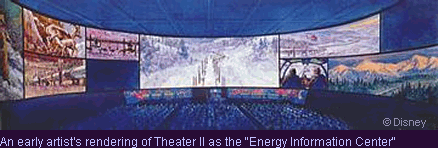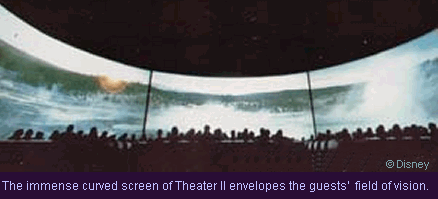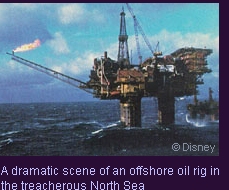 |
Home > Theater 2 > Films > Original

After experiencing the prehistoric diorama, guests found themselves within a second theater, known as
the EPCOT Energy Information Center. Here, a live-action film was shown that recorded the intense amount
of toil and ingenuity required to obtain energy for our use today.

The film opened in the middle of a field of solar mirrors in the California desert to propose the idea
that we may one day regularly use the sun as a major source of energy. From there, guests were shown how
our primary source of energy, crude oil, was extracted as well as techniques used for discovering new
deposits. From the deserts of the Mid-East,to the treacherous waters of the North Sea, to the snows of
Alaska, each of these places were explored to demonstrate the harsh environments mankind was willing to
brave to obtain oil. Guests were then taken deep beneath the earth and shown how coal, another essential fossil fuel, was
mined and extracted.
A number of short segments followed to demonstrate how, synthetic fuels, geothermal, wind and hydroelectric
power played an ever-increasing role in modern energy production.
The film then focused on new and emerging forms of energy production such as nuclear fission as well as
the possibility of nuclear fusion.
Bringing guests back to EPCOT Center, the film then showed them how the photovoltaic cells on the roof
of the very building they were in helped power their "ride of sunshine" thorough the Universe of Energy.
Finally, the film concluded with a spectacular space shuttle launch that marked the beginning of the show's
finale.
The Theater II film was shown on three massive 70mm motion projection screens that together formed a
giant wraparound screen that measured 210 feet wide and 30 feet high. The 218° field of view created,
by the wrap-around screen was was designed to extend beyond the viewers' peripheral vision, effectively
placing the guests right in the middle of the action.

To shoot the twelve and a half minute film, Disney filmmakers custom-designed a camera rig that
incorporated three 70mm cameras that filmed in synchronization with each other. The cameras were
placed on a special mounting rig with their lenses focused on three highly polished, precisely
angled mirrors to produce an almost seamless image. It was the only camera of its kind built for
the screen size used in Theater II, as well as the only camera that was capable of shooting on a
continual curve of about 120°.
 Norman Gerard and Jerry Sims, directors of the film, along with the Disney film crew of seven
took the 550-pound camera rig all over the world to capture the different sequences used in the
film. Many of the locations were not only remote and difficult to reach, but very hazardous
environments to film in. Jack Smith, who was responsible for the film design in the pavilion
recalled, "If your plane [went] down over the Alaskan wastes, well... that's lunch!" The crew
also had to deal with harsh climatic conditions such as the sweltering deserts of the Middle East,
to the icy tundra of Prudhoe Bay, to the freezing and treacherous waters of the North Sea. During
Norman Gerard and Jerry Sims, directors of the film, along with the Disney film crew of seven
took the 550-pound camera rig all over the world to capture the different sequences used in the
film. Many of the locations were not only remote and difficult to reach, but very hazardous
environments to film in. Jack Smith, who was responsible for the film design in the pavilion
recalled, "If your plane [went] down over the Alaskan wastes, well... that's lunch!" The crew
also had to deal with harsh climatic conditions such as the sweltering deserts of the Middle East,
to the icy tundra of Prudhoe Bay, to the freezing and treacherous waters of the North Sea. During
 filming in the North Sea of an offshore drilling platform, it was reported that temperatures dropped
so low, that the photographic mechanisms within the cameras actually iced up. Crews had to lug the
cumbersome camera rig indoors and literally thaw each camera out before shooting could continue.
filming in the North Sea of an offshore drilling platform, it was reported that temperatures dropped
so low, that the photographic mechanisms within the cameras actually iced up. Crews had to lug the
cumbersome camera rig indoors and literally thaw each camera out before shooting could continue.
By the time filming of the motion picture was complete, the crew had brought back enough footage
to make a film the length of "Gone With the Wind."

|
 |
|
|





